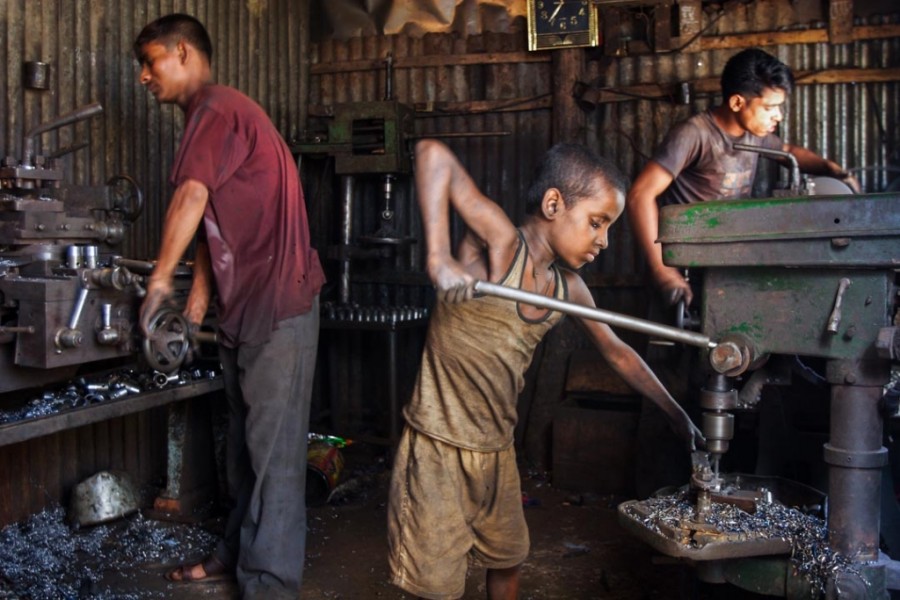
Published :
Updated :

The first and foremost cause of child labour in Bangladesh is the economic condition. It is very difficult for poor families to pay for children's education. As a result, the parents lose the motivation to send them to school. In this situation, parents consider it profitable to earn income by engaging the child in the father's profession or any other profession without considering the age. On the other hand, children who are deprived of the opportunity to go to school or drop out are engaged in various activities. Recruiting authorities are also enthusiastic about hiring children as they can be employed at low wage.
The socio-economic condition of Bangladesh is also one of the reasons for child labour. In our society, if the father or head of the family dies, then the education of the members of that family become a far cry. When poor parents are separated in a family breakup, there is no one to help the children. In addition, due to non-adoption of family planning in poor families, the majority of the children face severe financial difficulties.
Natural disasters like river erosion, floods, droughts, tidal surges and earthquakes are recurrent phenomena every year. Every such incident is constantly pushing children to earn for their families. Due to the low education, poverty and lack of awareness of the parents, they consider education as a non-profit activity. They do not have the patience to bear the cost of education for 10 to 15 years. Due to the need of domestic workers for domestic work in urban locations, children who are school-going are also drawn to the cities for doing household chores.
The Constitution of the People's Republic of Bangladesh recognises the fundamental rights of all citizens, including children. Articles 11, 14, 15, 16, 17, 18, 19 and 20 of the Constitution, that is, the principles of governing the state, emphasise the need to take special measures for the physically and mentally handicapped, including compulsory primary education for children. The fundamental rights of all citizens as human beings are guaranteed in Articles 27, 28, 29, 31, 34, 37, 38, 39, 40 and 41 of the Fundamental Rights section. In particular, forced labour is strictly prohibited and there is a guarantee of legal action in the event of a violation of rights.
The need for a policy for a positive change in the child labour situation in Bangladesh has long been felt by the public and private sectors as well as our educated sections. In the light of the changes taking place in the economic life, socio-culture of Bangladesh and the recent changes in the national and international arena, necessary elements have been included in the policy. The main goal of this policy is to make meaningful changes in the lives of children by withdrawing them from all types of child labour, including risky and inferior types of labour.
The goals of the National Child Labour Elimination Policy, 2010 are: to rehabilitate children engaged in various forms of labour, including hazardous and degrading labour; to involve working parents in income-generating activities to lift them out of the cycle of poverty and to provide scholarships and incentives to bring working children back to school. Special attention should be given to children affected by natural disasters and emphasis should be given to bring indigenous communities and children with disabilities back to proper environment. Strengthening the institutional basis for legislation and its implementation, raising awareness among parents, the general public and civil society about the harmful effects of child labour and adopting various short, medium and long term strategies and programs will help eradicate child labour.
Child labour exists in Bangladesh mainly in two sectors. Formal sector includes industries, commercial establishments, communication and transportation system, ship breaking etc. Informal sector comprises agriculture, animal husbandry, fishing / fish farming, housework, construction work, brick breaking, rickshaw pulling etc. Children are usually employed in different organisations or jobs in six ways, as (1) trainees; (2) transfer; (3) casual; (4) apprentice; (5) temporary and (6) permanent staff. Although child labour is banned in Bangladesh as in almost all countries of the world, employers are interested in employing children as they can be employed in longer working hours with lower wages.
The initiatives already taken by the government related to education, health and nutrition for the children engaged in labour have to be fully implemented. Coordination activities must be intensified for the effective and efficient implementation of existing initiatives by local and national level non-governmental organisations. In addition, long-term activities should be taken up without delay and urgent steps should be taken to determine strategies for effective implementation. If the existing laws and regulations related to child and child labour can be restructured and future action plans can be formulated and implemented, we can hope to part with the perils of the degrading system.


 For all latest news, follow The Financial Express Google News channel.
For all latest news, follow The Financial Express Google News channel.